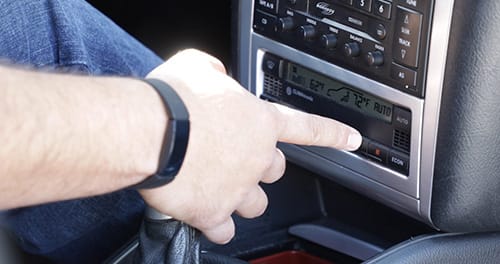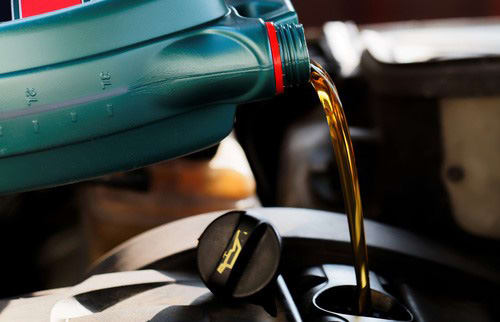Is Your Vehicle Prepared for Fall? | 9-Step Maintenance Checklist
- Oct 9, 2019

9 TIPS TO HELP PREPARE YOUR CAR FOR FALL
1. TIRE CARE
ROTATE YOUR TIRES
Your owner’s manual will likely include the recommended interval for tire rotations—typically every 5,000 to 10,000 miles. Regular rotations help the tires wear evenly over their lifespan, particularly if you have a front-wheel drive vehicle, and can prevent front-end misalignment.
CHECK FOR EVEN WEAR AND INFLATION
You also want to ensure that your tires are inflated to the recommended levels; underinflated tires can cause tread wear and reduce gas mileage, while overinflated tires can result in a loss of traction while also causing premature wear. Make sure to check your brake pads as well. If you have any concerns about the status of your brakes or tires, go to a trusted professional for an evaluation.

2. TEST YOUR HEATER
Make sure your heater is in working order, and that your defroster is operational.

3. TRY YOUR WINDSHIELD WIPERS
Well-functioning wipers are critical to maintaining good visibility in poor weather. Before the rainy season hits in full force, take a few minutes to make sure your wipers still have good grip, and replace them if necessary.

4. REPLACE OR SERVICE YOUR AIR FILTER
Your engine air filter protects your engine from contaminants that can cause damage and premature wear. If you use a disposable filter, it typically needs to be replaced every 15,000 miles or so. K&N High-Flow Air Filters™ are washable and reusable, and are designed to last for the entire life of your vehicle—so you can enjoy the convenience of only servicing your filter approximately every 50,000 miles (under normal highway driving conditions).
If you have a K&N washable filter already installed, check to see if the dirt is exceeding the wire mesh—if so, it’s time to wash and reinstall.

5. REVIEW YOUR SERVICE SCHEDULE + CHECK FLUIDS
Frequently review your owner’s manual and take note of the manufacturer’s recommended service schedule. Now is a good time to make sure your vehicle is up-to-date on all recommended maintenance—including oil changes, transmission services, and brake pad/rotor replacement—and to check all fluid levels.
Keep a small notebook in your glove box or use a notepad app on your phone to take note of any services or repairs—including oil changes, fluid checks, tire rotations, and gas mileage. Sticking to the recommended service schedule will help keep your vehicle running smoothly, and if you decide to sell, buyers will appreciate evidence that you’ve performed consistent maintenance.

6. CHECK YOUR COOLING SYSTEM
While the engine is completely cool, examine your radiator and hoses—any cracks or leaks should be repaired, and all connections should be snug. Shiny areas on belts and hoses are a sign of serious wear, and are often the result of extreme heat damage. While you’re at it, make sure to fill your coolant reservoir to the recommended level (a 50/50 mixture of coolant and distilled water is standard). Manufacturers generally advise that coolant be completely flushed and replaced every two years.
7. LISTEN FOR UNUSUAL SOUNDS
Be aware of new sounds and vibrations. Take a few minutes to roll down your windows as you’re driving around town, and listen for anything out of the ordinary. Squeaks, rattles, and knocks should be investigated and diagnosed.
8. CHECK YOUR CABIN FILTER
For extra protection against allergens and airborne road pollution, consider installing a good quality cabin filter. Ragweed pollen, mold, and dust mites are common fall allergy triggers, and a cabin filter can help remove particles from your cabin and keep you feeling healthier. K&N washable cabin filters never need to be replaced, and help capture mold, dust, mildew, fungi, germs, bacteria, and other particles as they circulate.

9. TEST YOUR LIGHTS
Make sure that all of your lights are functioning, and replace any bulbs if needed.
Taking a few minutes to complete preventative maintenance can help you avoid expensive repairs down the road. To explore all of K&N’s premium protection products for your vehicle, click the button below and enter your vehicle’s information in the search bar.
*This post is for informational purposes only, and we do not warrant that the information provided will produce any specific results or achieve any intended purposes. Every vehicle is different and subject to different road conditions and wear and tear. You should always follow your manufacturer’s recommended service schedule, consult the vehicle owner’s manual, and/or have your vehicle evaluated by a properly trained mechanic.
Modifying your vehicle can affect its safety and road worthiness. Modifications, including maintenance and cleaning, may void any applicable warranties to a product or vehicle. You are advised to contact the product manufacturer or authorized reseller prior to conducting any repairs, maintenance, or modifications. The information provided herein is provided is not intended for any particular product or purpose and may not be suitable for all users, vehicles, or products. K&N will not be responsible for any damage to persons or property, including but not limited to any direct, indirect, incidental, consequential, punitive, or exemplary damages arising out of or related to your use of or reliance on the content contained in this post. Please read the applicable instruction prior to use of any K&N or other manufacturers’ product.












